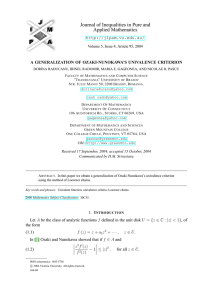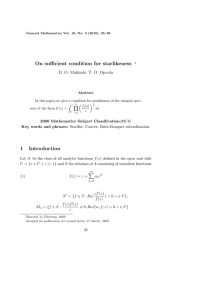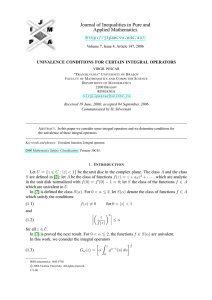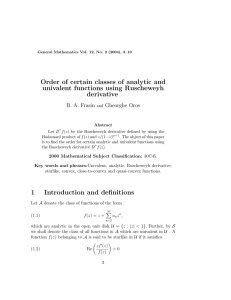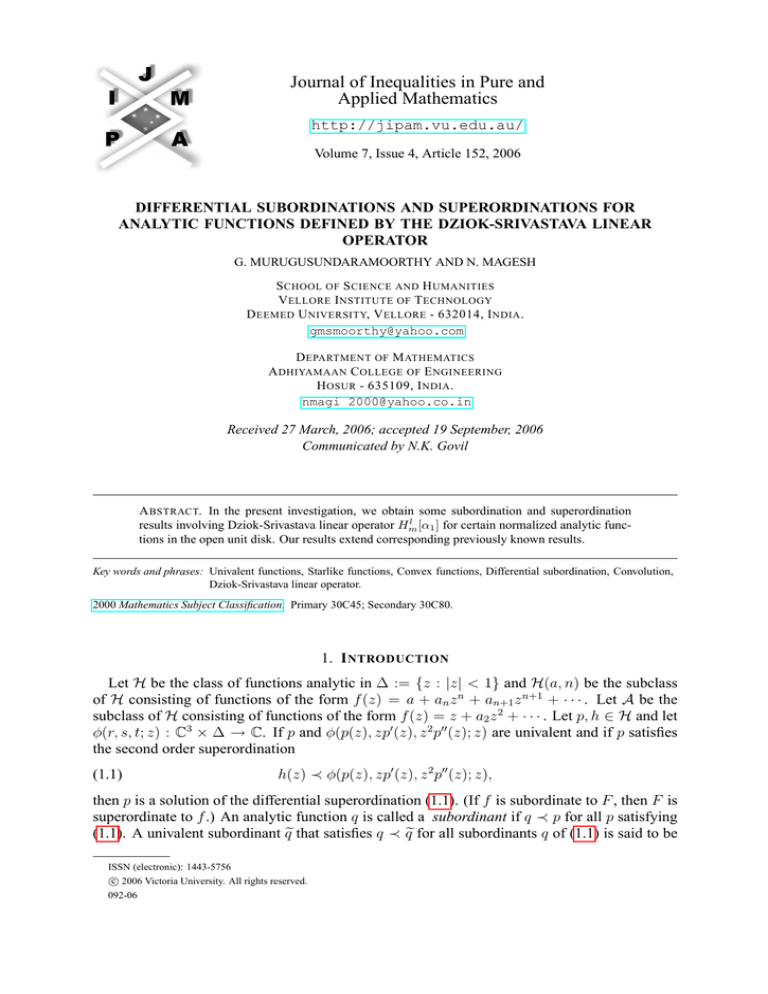
Journal of Inequalities in Pure and
Applied Mathematics
http://jipam.vu.edu.au/
Volume 7, Issue 4, Article 152, 2006
DIFFERENTIAL SUBORDINATIONS AND SUPERORDINATIONS FOR
ANALYTIC FUNCTIONS DEFINED BY THE DZIOK-SRIVASTAVA LINEAR
OPERATOR
G. MURUGUSUNDARAMOORTHY AND N. MAGESH
S CHOOL OF S CIENCE AND H UMANITIES
V ELLORE I NSTITUTE OF T ECHNOLOGY
D EEMED U NIVERSITY, V ELLORE - 632014, I NDIA .
gmsmoorthy@yahoo.com
D EPARTMENT OF M ATHEMATICS
A DHIYAMAAN C OLLEGE OF E NGINEERING
H OSUR - 635109, I NDIA .
nmagi_2000@yahoo.co.in
Received 27 March, 2006; accepted 19 September, 2006
Communicated by N.K. Govil
A BSTRACT. In the present investigation, we obtain some subordination and superordination
l
results involving Dziok-Srivastava linear operator Hm
[α1 ] for certain normalized analytic functions in the open unit disk. Our results extend corresponding previously known results.
Key words and phrases: Univalent functions, Starlike functions, Convex functions, Differential subordination, Convolution,
Dziok-Srivastava linear operator.
2000 Mathematics Subject Classification. Primary 30C45; Secondary 30C80.
1. I NTRODUCTION
Let H be the class of functions analytic in ∆ := {z : |z| < 1} and H(a, n) be the subclass
of H consisting of functions of the form f (z) = a + an z n + an+1 z n+1 + · · · . Let A be the
subclass of H consisting of functions of the form f (z) = z + a2 z 2 + · · · . Let p, h ∈ H and let
φ(r, s, t; z) : C3 × ∆ → C. If p and φ(p(z), zp0 (z), z 2 p00 (z); z) are univalent and if p satisfies
the second order superordination
(1.1)
h(z) ≺ φ(p(z), zp0 (z), z 2 p00 (z); z),
then p is a solution of the differential superordination (1.1). (If f is subordinate to F , then F is
superordinate to f .) An analytic function q is called a subordinant if q ≺ p for all p satisfying
(1.1). A univalent subordinant qe that satisfies q ≺ qe for all subordinants q of (1.1) is said to be
ISSN (electronic): 1443-5756
c 2006 Victoria University. All rights reserved.
092-06
2
G. M URUGUSUNDARAMOORTHY
AND
N. M AGESH
the best subordinant. Recently Miller and Mocanu [14] obtained conditions on h, q and φ for
which the following implication holds:
h(z) ≺ φ(p(z), zp0 (z), z 2 p00 (z); z) ⇒ q(z) ≺ p(z).
Using the results of Miller and Mocanu [14], Bulboacă [5] considered certain classes of first
order differential superordinations as well as superordination-preserving integral operators [4].
Ali et al. [1] have used the results of Bulboacă [5] and obtained sufficient conditions for certain
normalized analytic functions f (z) to satisfy
q1 (z) ≺
zf 0 (z)
≺ q2 (z),
f (z)
where q1 and q2 are given univalent functions in ∆ with q1 (0) = 1 and q2 (0) = 1. Shanmugam
et al. [19] obtained sufficient conditions for a normalized analytic function f (z) to satisfy
f (z)
q1 (z) ≺ 0
≺ q2 (z)
zf (z)
z 2 f 0 (z)
and q1 (z) ≺
≺ q2 (z)
{f (z)}2
where q1 and q2 are given univalent functions in ∆ with q1 (0) = 1 and q2 (0) = 1.
In [2], for functions f ∈ A such that δ > 0,
(
δ )
zf 0 (z) f (z)
<
> 0,
z ∈ ∆,
f (z)
z
a class of Bazilevic type functions was considered and certain properties were studied. In this
paper motivated by Liu [11], we define a class
(
)
δ
δ
f (z)
zf 0 (z) f (z)
1 + Az
B(λ, δ, A, B) := f ∈ A : (1 − λ)
+λ
≺
,
z
f (z)
z
1 + Bz
where δ > 0, λ ≥ 0, −1 ≤ B < A ≤ 1 and studied certain interesting properties based on
subordination. Further we obtained a sandwich result for functions in the class B(λ, δ, A, B).
2. P RELIMINARIES
For our present investigation, we shall need the following definition and results.
Definition 2.1 ([14, Definition 2, p. 817]). Denote by Q, the set of all functions f (z) that are
analytic and injective on ∆ − E(f ), where
E(f ) = ζ ∈ ∂∆ : lim f (z) = ∞
z→ζ
and are such that f 0 (ζ) 6= 0 for ζ ∈ ∂∆ − E(f ).
Lemma 2.1 ([13, Theorem 3.4h, p. 132]). Let q(z) be univalent in the unit disk ∆ and θ
and φ be analytic in a domain D containing q(∆) with φ(w) 6= 0 when w ∈ q(∆). Set
Q(z) = zq 0 (z)φ(q(z)), h(z) = θ(q(z)) + Q(z). Suppose that
(1) Q(z)
starlike
univalent in ∆, and
n is
o
zh0 (z)
(2) < Q(z) > 0 for z ∈ ∆.
If
θ(p(z)) + zp0 (z)φ(p(z)) ≺ θ(q(z)) + zq 0 (z)φ(q(z)),
then p(z) ≺ q(z) and q(z) is the best dominant.
J. Inequal. Pure and Appl. Math., 7(4) Art. 152, 2006
http://jipam.vu.edu.au/
D IFFERENTIAL S UBORDINATIONS AND S UPERORDINATIONS FOR A NALYTIC F UNCTIONS
3
Lemma 2.2 ([19]). Let q be a convex univalent function in ∆ and ψ, γ ∈ C with
zq 00 (z) ψ
< 1+ 0
+
> 0.
q (z)
γ
If p(z) is analytic in ∆ and
ψp(z) + γzp0 (z) ≺ ψq(z) + γzq 0 (z)
then p(z) ≺ q(z) and q(z) is the best dominant.
Lemma 2.3 ([5]). Let q(z) be convex univalent in the unit disk ∆ and ϑ and ϕ be analytic in a
domain D containing q(∆). Suppose that
(1) < [ϑ0 (q(z))/ϕ(q(z))] > 0 for z ∈ ∆,
(2) zq 0 (z)ϕ(q(z)) is starlike univalent in ∆.
If p(z) ∈ H[q(0), 1] ∩ Q, with p(∆) ⊆ D, and ϑ(p(z)) + zp0 (z)ϕ(p(z)) is univalent in ∆,
and
(2.1)
ϑ(q(z)) + zq 0 (z)ϕ(q(z)) ≺ ϑ(p(z)) + zp0 (z)ϕ(p(z)),
then q(z) ≺ p(z) and q(z) is the best subordinant.
Lemma 2.4 ([14, Theorem 8, p. 822]). Let q be convex univalent in ∆ and γ ∈ C. Further
assume that < [γ] > 0. If p(z) ∈ H[q(0), 1] ∩ Q, p(z) + γzp0 (z) is univalent in ∆, then
q(z) + γzq 0 (z) ≺ p(z) + γzp0 (z)
implies q(z) ≺ p(z) and q(z) is the best subordinant.
P
P∞
n
n
For two functions f (z) = z + ∞
n=2 an z and g(z) = z +
n=2 bn z , the Hadamard product
(or convolution) of f and g is defined by
∞
X
(f ∗ g)(z) := z +
an bn z n =: (g ∗ f )(z).
n=2
For αj ∈ C (j = 1, 2, . . . , l) and βj ∈ C \ {0, −1, −2, . . .} (j = 1, 2, . . . , m), the generalized
hypergeometric function l Fm (α1 , . . . , αl ; β1 , . . . , βm ; z) is defined by the infinite series
∞
X
(α1 )n · · · (αl )n z n
F
(α
,
.
.
.
,
α
;
β
,
.
.
.
,
β
;
z)
:=
l m
1
l
1
m
(β1 )n · · · (βm )n n!
n=0
(l ≤ m + 1; l, m ∈ N0 := {0, 1, 2, . . .})
where (a)n is the Pochhammer symbol defined by
Γ(a + n)
1,
(n = 0);
(a)n :=
=
a(a + 1)(a + 2) · · · (a + n − 1), (n ∈ N := {1, 2, 3 . . .}).
Γ(a)
Corresponding to the function
h(α1 , . . . , αl ; β1 , . . . , βm ; z) := z l Fm (α1 , . . . , αl ; β1 , . . . , βm ; z),
l
the Dziok-Srivastava operator [7] (see also [8, 20]) Hm
(α1 , . . . , αl ; β1 , . . . , βm ) is defined by
the Hadamard product
(2.2)
l
Hm
(α1 , . . . , αl ; β1 , . . . , βm )f (z)
:= h(α1 , . . . , αl ; β1 , . . . , βm ; z) ∗ f (z)
∞
X
(α1 )n−1 · · · (αl )n−1 an z n
=z+
.
(β1 )n−1 · · · (βm )n−1 (n − 1)!
n=2
J. Inequal. Pure and Appl. Math., 7(4) Art. 152, 2006
http://jipam.vu.edu.au/
4
G. M URUGUSUNDARAMOORTHY
AND
N. M AGESH
For brevity, we write
l
l
Hm
[α1 ]f (z) := Hm
(α1 , . . . , αl ; β1 , . . . , βm )f (z).
It is easy to verify from (2.2) that
(2.3)
l
l
l
[α1 ]f (z).
[α1 ]f (z))0 = α1 Hm
[α1 + 1]f (z) − (α1 − 1)Hm
z(Hm
Special cases of the Dziok-Srivastava linear operator include the Hohlov linear operator [9],
the Carlson-Shaffer linear operator L(a, c) [6], the Ruscheweyh derivative operator Dn [18],
the generalized Bernardi-Libera-Livingston linear integral operator (cf. [3], [10], [12]) and the
Srivastava-Owa fractional derivative operators (cf. [16], [17]).
The main object of the present paper is to find sufficient conditions for certain normalized
analytic functions f (z) to satisfy
l
δ
Hm [α1 ]f (z)
q1 (z) ≺
≺ q2 (z)
z
where q1 and q2 are given univalent functions in ∆. Also, we obtain the number of known results
as special cases.
3. M AIN R ESULTS
We begin with the following:
Theorem 3.1. Let q(z) be univalent in ∆, λ ∈ C and α1 > 0, δ > 0. Suppose q(z) satisfies
zq 00 (z) λ
+
> 0.
(3.1)
< 1+ 0
q (z)
δ
If f ∈ A satisfies the subordination,
l
δ
l
δ l
Hm [α1 ]f (z)
Hm [α1 ]f (z)
Hm [α1 + 1]f (z)
(3.2) (1 − λα1 )
+ λα1
l [α ]f (z)
z
z
Hm
1
λ
≺ q(z) + zq 0 (z),
δ
then
l
δ
Hm [α1 ]f (z)
≺ q(z)
z
and q(z) is the best dominant.
Proof. Define the function p(z) by
(3.3)
p(z) :=
l
Hm
[α1 ]f (z)
z
δ
.
Then
l
δ l
zp0 (z)
Hm [α1 ]f (z)
Hm [α1 + 1]f (z)
:= α1
−1 ,
l [α ]f (z)
δ
z
Hm
1
hence the hypothesis (3.2) of Theorem 3.1 yields the subordination:
λzp0 (z)
λzq 0 (z)
p(z) +
≺ q(z) +
.
δ
δ
Now Theorem 3.1 follows by applying Lemma 2.2 with ψ = 1 and γ = λδ .
When l = 2, m = 1, α1 = a, α2 = 1, and β1 = c in Theorem 3.1, we have the following
corollary.
J. Inequal. Pure and Appl. Math., 7(4) Art. 152, 2006
http://jipam.vu.edu.au/
D IFFERENTIAL S UBORDINATIONS AND S UPERORDINATIONS FOR A NALYTIC F UNCTIONS
5
Corollary 3.2. Let q(z) be univalent in ∆, λ ∈ C and α1 > 0, δ > 0. Suppose q(z) satisfies
(3.1). If f ∈ A and satisfies the subordination,
δ
δ L(a, c)f (z)
L(a, c)f (z)
L(a + 1, c)f (z)
(3.4)
(1 − λa)
+ λa
z
z
L(a, c)f (z)
λ
≺ q(z) + zq 0 (z),
δ
then
δ
L(a, c)f (z)
≺ q(z)
z
and q(z) is the best dominant.
By taking l = 1, m = 0 and α1 = 1 in Theorem 3.1, we get the following corollary.
Corollary 3.3. Let q(z) be univalent in ∆, λ ∈ C and α1 > 0, δ > 0. Suppose q(z) satisfies
(3.1). If f ∈ A and satisfies the subordination,
δ
δ 0 f (z)
f (z)
zf (z)
λ
(3.5)
(1 − λ)
+λ
≺ q(z) + zq 0 (z),
z
z
f (z)
δ
then
f (z)
z
δ
≺ q(z)
and q(z) is the best dominant.
Corollary 3.4. Let −1 ≤ B < A ≤ 1 and (3.1) hold. If f ∈ A and
l
δ
l
δ l
Hm [α1 ]f (z)
Hm [α1 ]f (z)
Hm [α1 + 1]f (z)
+ λα1
(1 − λα1 )
l [α ]f (z)
z
z
Hm
1
λ(A − B)z 1 + Az
≺
+
,
δ(1 + Bz)2 1 + Bz
then
and
1+Az
1+Bz
l
Hm
[α1 ]f (z)
z
δ
≺
1 + Az
1 + Bz
is the best dominant.
Theorem 3.5. Let q(z) be univalent in ∆, λ, δ ∈ C. Suppose q(z) satisfies
zq 00 (z) zq 0 (z)
(3.6)
< 1+ 0
−
> 0.
q (z)
q(z)
If f ∈ A satisfies the subordination:
l
Hm [α1 + 1]f (z)
zq 0 (z)
(3.7)
1 + γδα1
−
1
≺
1
+
γ
,
l [α ]f (z)
Hm
q(z)
1
then
l
Hm
[α1 ]f (z)
z
δ
≺ q(z)
and q(z) is the best dominant.
J. Inequal. Pure and Appl. Math., 7(4) Art. 152, 2006
http://jipam.vu.edu.au/
6
G. M URUGUSUNDARAMOORTHY
AND
N. M AGESH
Proof. Define the function p(z) by
p(z) =
l
Hm
[α1 ]f (z)
z
δ
.
It is clear that p(0) = 1 and p(z) is analytic in ∆. By using the identity (2.3), from (3.3) we get,
l
Hm [α1 + 1]f (z)
zp0 (z)
(3.8)
= α1 δ
−1 .
l [α ]f (z)
p(z)
Hm
1
Using (3.8) in (3.7), we see that the subordination becomes
1+γ
zp0 (z)
zq 0 (z)
≺1+γ
.
p(z)
q(z)
By setting
γ
,
w
we observe that ϕ and θ are analytic in C \ {0}. Also we see that
θ(w) = 1
and
ϕ(w) =
Q(z) := zq 0 (z)ϕ(q(z)) =
γzq 0 (z)
,
q(z)
and
h(z) := ϑ(q(z)) + Q(z) = 1 + γ
zq 0 (z)
.
q(z)
It is clear that Q(z) is starlike univalent in ∆ and
zq 00 (z) zq 0 (z)
zh0 (z)
<
=< 1+ 0
−
≥ 0.
Q(z)
q (z)
q(z)
By the hypothesis of Theorem 3.5, the result now follows by an application of Lemma 2.1. 1
Specializing the values of l = 1, m = 0, α1 = 1 and q(z) = (1−z)
(b ∈ C − {0}), γ =
2b
and δ = 1 in Theorem 3.5 above, we have the following corollary as stated in [21].
1
b
Corollary 3.6. Let b be a non zero complex number. If f ∈ A and
1 zf 0 (z)
1+z
1+
−1 ≺
,
b f (z)
1−z
then
f (z)
1
≺
z
(1 − z)2b
1
and (1−z)
2b is the best dominant.
1
Choosing the values of l = 1, m = 0, α1 = 1 and q(z) = (1−z)
(b ∈ C − {0}), γ =
2ab
and δ = a 6= 0 in Theorem 3.5 above, we have the following corollary as stated in [15].
1
b
Corollary 3.7. Let b be a non zero complex number. If f ∈ A and
1 zf 0 (z)
1+z
1+
−1 ≺
,
b f (z)
1−z
then
a
f (z)
1
≺
z
(1 − z)2ab
1
where a 6= 0 is a complex number and (1−z)
2ab is the best dominant.
J. Inequal. Pure and Appl. Math., 7(4) Art. 152, 2006
http://jipam.vu.edu.au/
D IFFERENTIAL S UBORDINATIONS AND S UPERORDINATIONS FOR A NALYTIC F UNCTIONS
7
1
Similarly for l = 2, m = 1, α1 = 1, α2 = 1, β1 = 1 and q(z) = (1−z)
(b ∈ C − {0}),
2b
1
γ = b and δ = 1 in Theorem 3.5 above, we get the following result as stated in [21].
Corollary 3.8. Let b be a non zero complex number. If f ∈ A and
1+z
1 zf 00 (z)
−1 ≺
1+
,
0
b f (z)
1−z
then
f 0 (z) ≺
and
1
(1−z)2b
1
(1 − z)2b
is the best dominant.
Next, applying Lemma 2.3, we have the following theorem.
Theorem 3.9. Let q(z) be convex univalent in ∆, λ ∈ C and 0 < δ < 1. Suppose f ∈ A
satisfies
δ
(3.9)
Re
>0
λ
l
δ
Hm [α1 ]f (z)
and
∈ H[q(0), 1] ∩ Q. Let
z
(1 − λα1 )
l
Hm
[α1 ]f (z)
z
δ
+ λα1
l
Hm
[α1 ]f (z)
z
δ l
Hm
[α1 + 1]f (z)
l [α ]f (z)
Hm
1
be univalent in ∆. If f ∈ A satisfies the superordination,
l
δ
Hm [α1 ]f (z)
λ 0
(3.10)
q(z) + zq (z) ≺ (1 − λα1 )
δ
z
l
δ l
Hm [α1 ]f (z)
Hm [α1 + 1]f (z)
+ λα1
l [α ]f (z)
z
Hm
1
then
l
Hm
[α1 ]f (z)
z
δ
l
Hm
[α1 ]f (z)
z
δ
q(z) ≺
and q(z) is the best subordinant.
Proof. Define the function p(z) by
(3.11)
p(z) :=
.
Using (3.11), simple computation produces
l
δ l
zp0 (z)
Hm [α1 ]f (z)
Hm [α1 + 1]f (z)
:= α1
−1 ,
l [α ]f (z)
δ
z
Hm
1
then
λ
λ
q(z) + zq 0 (z) ≺ p(z) + zp0 (z).
δ
δ
λ
By setting ϑ(w) = w and φ(w) = δ , it is easily observed that ϑ(w) is analytic in C. Also,
φ(w) is analytic in C\{0} and φ(w) 6= 0, (w ∈ C\{0}).
J. Inequal. Pure and Appl. Math., 7(4) Art. 152, 2006
http://jipam.vu.edu.au/
8
G. M URUGUSUNDARAMOORTHY
AND
N. M AGESH
Since q(z) is a convex univalent function, it follows that
0
ϑ (q(z))
δ
<
=<
> 0, z ∈ ∆, δ, λ ∈ C, δ, λ 6= 0.
φ(q(z))
λ
Now Theorem 3.9 follows by applying Lemma 2.3.
Concluding the results of differential subordination and superordination, we state the following sandwich result.
Theorem 3.10. Let q1 and q2 be convex univalent in ∆, λ ∈ C and 0 < δ < 1. Suppose q2
δ
l
satisfies (3.1) and q1 satisfies (3.9). If Hm [αz1 ]f (z) ∈ H[q(0), 1] ∩ Q,
(1 − λα1 )
l
Hm
[α1 ]f (z)
z
δ
+ λα1
l
Hm
[α1 ]f (z)
z
δ l
Hm
[α1 + 1]f (z)
l [α ]f (z)
Hm
1
is univalent in ∆. If f ∈ A satisfies
(3.12)
λ
q1 (z) + zq10 (z)
δ
l
δ
l
δ l
Hm [α1 ]f (z)
Hm [α1 ]f (z)
Hm [α1 + 1]f (z)
≺ (1 − λα1 )
+ λα1
l [α ]f (z)
z
z
Hm
1
λ 0
≺ q2 (z) + zq2 (z),
δ
then
δ
l
Hm
[α1 ]f (z)
≺ q2 (z)
q1 (z) ≺
z
and q1 , q2 are respectively the best subordinant and best dominant.
R EFERENCES
[1] R.M. ALI, V. RAVICHANDRAN, M. HUSSAIN KHAN AND K.G. SUBRAMANIAN, Differential sandwich theorems for certain analytic functions, Far East J. Math. Sci., 15(1) (2005), 87–94.
[2] I.E. BAZILEVIC, On a case of integrability in quadratures of the Loewner-kuarev equation, Mat.
Sb., 37 (1955), 471–476.
[3] S.D. BERNARDI, Convex and starlike univalent functions, Trans. Amer. Math. Soc., 135 (1969),
429–446.
[4] T. BULBOACĂ, A class of superordination-preserving integral operators, Indag. Math., New Ser.,
13(3) (2002), 301–311.
[5] T. BULBOACĂ, Classes of first order differential superordinations, Demonstr. Math., 35(2) (2002),
287–292.
[6] B.C. CARLSON AND D.B. SHAFFER, Starlike and prestarlike hypergeometric functions, SIAM J.
Math. Anal., 15(4) (1984), 737–745.
[7] J. DZIOK AND H.M. SRIVASTAVA, Classes of analytic functions associated with the generalized
hypergeometric function, Appl. Math. Comput., 103(1) (1999), 1–13.
[8] J. DZIOK AND H.M. SRIVASTAVA, Certain subclasses of analytic functions associated with the
generalized hypergeometric function, Integral Transforms Spec. Funct., 14(1) (2003), 7–18.
[9] JU. E. HOHLOV, Operators and operations on the class of univalent functions, Izv. Vyssh. Uchebn.
Zaved. Mat., 10 (197) (1978) 83–89.
J. Inequal. Pure and Appl. Math., 7(4) Art. 152, 2006
http://jipam.vu.edu.au/
D IFFERENTIAL S UBORDINATIONS AND S UPERORDINATIONS FOR A NALYTIC F UNCTIONS
9
[10] R.J. LIBERA, Some classes of regular univalent functions, Proc. Amer. Math. Soc., 16 (1965),
755–758.
[11] M.S. LIU, Properties for some subclasses of analytic functions, Bull. Insti. Math. Acad. Sinica.,
30(1) (2002), 9–26.
[12] A.E. LIVINGSTON, On the radius of univalence of certain analytic functions, Proc. Amer. Math.
Soc., 17 (1966), 352–357.
[13] S.S. MILLER AND P.T. MOCANU, Differential Subordinations: Theory and Applications, Marcel
Dekker Inc., New York, (2000).
[14] S.S. MILLER AND P.T. MOCANU, Subordinants of differential superordinations, Complex Variables, 48(10) (2003), 815–826.
[15] M. OBRADOVIC, M.K. AOUF AND S. OWA, On some results for starlike functions of complex
order, Pub. De. L’ Inst. Math., 46 (60) (1989), 79–85.
[16] S. OWA, On the distortion theorems I, Kyungpook Math. J., 18(1) (1978), 53–59.
[17] S. OWA AND H.M. SRIVASTAVA, Univalent and starlike generalized hypergeometric functions,
Canad. J. Math., 39(5) (1987), 1057–1077.
[18] S. RUSCHEWEYH, New criteria for univalent functions, Proc. Amer. Math. Soc., 49 (1975), 109–
115.
[19] T.N. SHANMUGAM, V. RAVICHANDRAN AND S. SIVASUBRAMANIAN, Differential sandwich theorems for some subclasses of analytic functions, Aust. J. Math. Anal. Appl., 3(1) (2006),
Art. 8.
[20] H.M. SRIVASTAVA, Some families of fractional derivative and other linear operators associated
with analytic, univalent and multivalent functions, Proc. International Conf. Analysis and its Applications, Allied Publishers Ltd, New Delhi (2001), 209–243.
[21] H.M. SRIVASTAVA AND A.Y. LASHIN, Some applications of the Briot-Bouquet differential subordination, J. Inequal. Pure Appl. Math., 6(2) (2005), Art. 41. [ONLINE: http://jipam.vu.
edu.au/article.php?sid=510].
J. Inequal. Pure and Appl. Math., 7(4) Art. 152, 2006
http://jipam.vu.edu.au/

